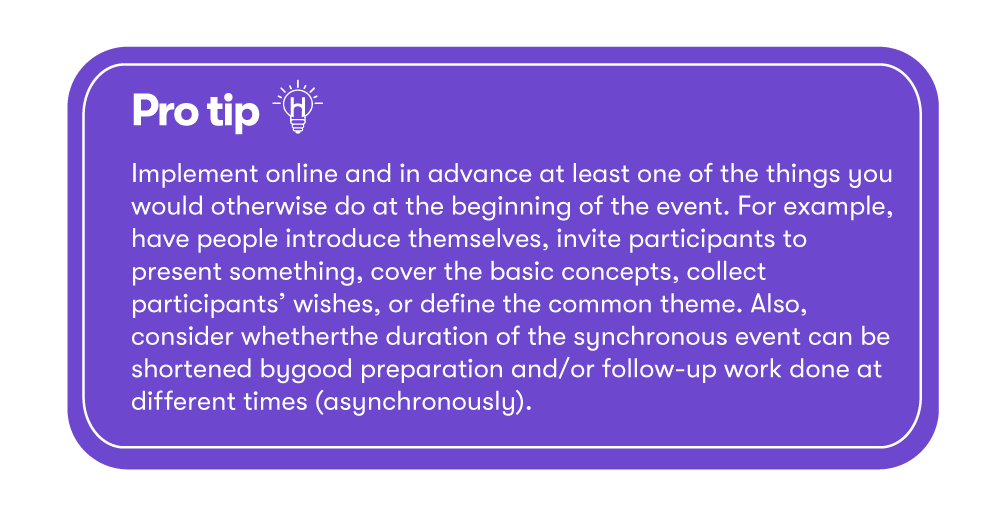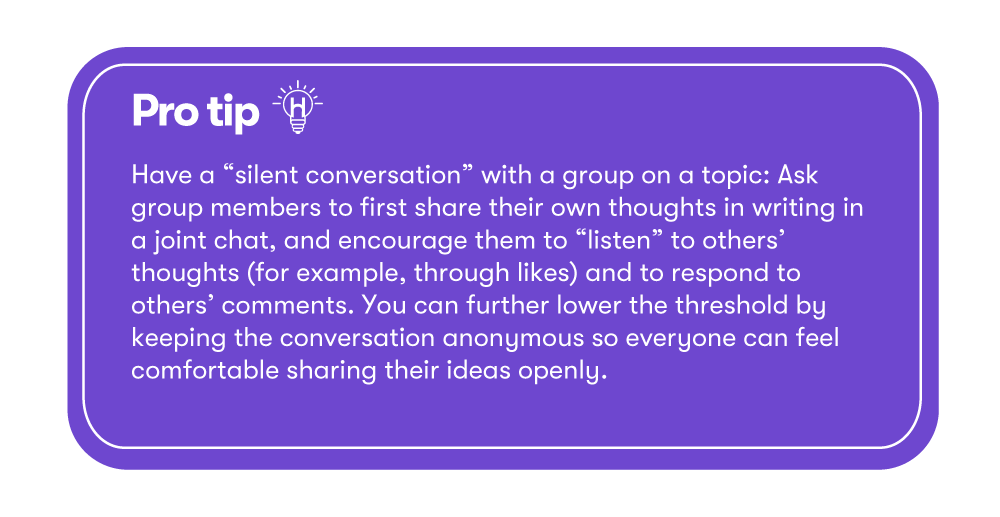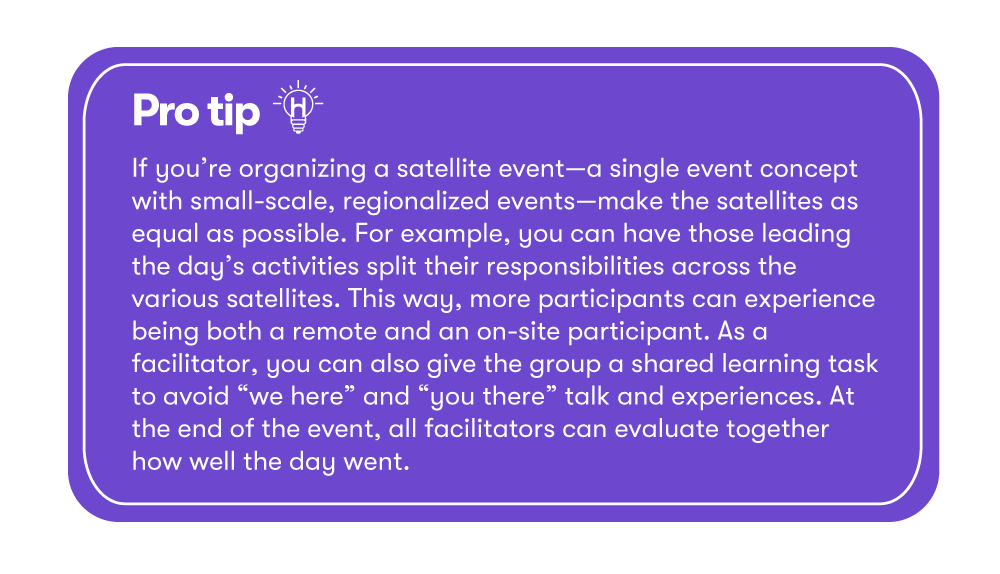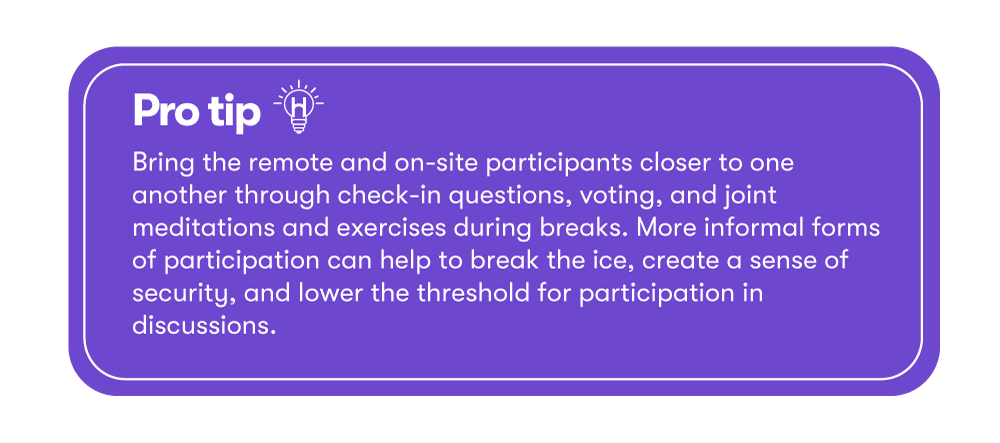
5 tips for organizing a successful hybrid event or hybrid training
Due to the pandemic, trainers, consultants, event organizers, and leaders have been forced to try out new ways of working and facilitating. At times, fully virtual events were the only option—aside from cancelling the event altogether. But over the past year, the hybrid model has become an increasingly common approach.
Grab our free template for hybrid workshops and get some inspiration for your next workshop!
What exactly is a hybrid event, and how can you successfully organize one? We put our thoughts and experiences on hybrid events and share five tips for success.
- What is a hybrid event
- When to host a hybrid event
- The benefits of hybrid events
- Tips for organizing successful hybrid events
- Hybrid events aren’t going away
What is a hybrid event?
Hybrid events are by no means a new phenomena—they have been used for years to provide flexibility when organizing events and training. However, the pandemic has taken the need for digital collaboration and hybrid facilitation to a whole new level.
A hybrid event is a meeting, workshop, conference, tradeshow, or other event in which some participants meet face-to-face in a shared space, while others join online—either via their own devices or as groups from separate satellite points.
When to host a hybrid event
If you’re wondering whether a hybrid event is the right solution, consider the following questions:
- Purpose: What are you aiming to achieve with your event? What are you hoping participants get out of it?
- Costs: What’s your budget for the event?
- Travelling distance: Are you expecting participants to travel? If so, from how far?
You can send out a pre-event survey to gauge participants’ feelings and plans. Ultimately, if some participants are able and willing to join in person and you can facilitate that, then feel free to try a hybrid approach.
In-person events might work better for team building and networking, but that doesn’t mean they’re impossible to facilitate in a virtual space.
The benefits of hybrid events
With hybrid events, you can invite thousands of people and maintain high levels of engagement and participation—without compromising on safety and flexibility.
Here are some reasons you might choose to host a hybrid event via a shared digital collaboration platform:
- Combine the benefits of meeting in-person with the practicalities and accessibility of
- virtual events
- Increase attendance by giving people options for joining
- Engage participants on a deeper level and stay connected before and after the event
- Gain insight into participants’ engagement levels with analytics
- Give sponsors increased exposure through both in-person and virtual attendees
- Reduce your organization’s carbon footprint
Still, hybrid events can definitely be more challenging to facilitate than face-to-face or fully digital events. To make the most of your upcoming hybrid event, put the following tips into practice.
Tips for organizing successful hybrid events
1. Prepare well for your hybrid event
Whether you’re planning a fully remote or hybrid event, simply moving your in-person event online won’t cut it. Letting go of traditional models and shifting your mindset is key to delivering a remarkable hybrid event—though it does require a good amount of preparation.
As you prepare, consider whether you’re trying to replicate what you previously did in-person, or if you’re open to achieving the same goal with your event but in a different way. For example, while you might have previously hosted an eight-hour conference in-person, consider how remote attendees would experience this approach. Could you instead restructure your program into a series of shorter sessions?
Allen Bessel, Senior Vice President of Client Experience at Optimé International says, “My perspective today is that there is nothing I could do in an in-person training session that I can’t do virtually, and in some cases, it’s turned out to be more effective.”
Preparing for your hybrid event can include:
- Rethinking your content to make space for active participation
- Revising practical instructions
- Technical preparation (especially for remote participants) to ensure good audio and image quality
- Forming into groups and doing introductions
- Discussing participants’ expectations and wishes
- Presenting questions or exploring the content itself, through videos or other material
Of course, it’s not necessary to do all these preparations for every event. Rather, you can choose which methods are the most important for the participants and which fit in with their daily lives. Good preparation and being familiar with the technology will give you confidence and peace of mind when facilitating the event.

2. Put remote participants first
A top concern with hybrid events is that remote participants are left out and feel like “second class” participants. Face-to-face participants can easily get the facilitator’s attention because face-to-face communication enables more diverse ways to communicate. In order for everyone to get the most out of the event, bring all participants to the same level by planning the meeting so that the needs of remote participants are kept to the forefront.
In practice, this means that ways of participation in face-to-face meetings, such as using flip charts, whiteboards, sticky notes, and hand-up voting, need to be put aside. This doesn’t mean you should also put aside inclusion and engagement, but that it should be done digitally. Participants can vote, brainstorm, reflect, submit tasks, and ask questions through their mobile phones or laptops—regardless of whether they’re in-person or remote. When the same digital platform is used for both the live event itself and for preparation, the platform will already be familiar to everyone and logging in will be easy.
Make sure to record your sessions when possible so that participants who missed any part of the event can access the content at a convenient time for them. You can share these on-demand videos in the same digital platform so that they’re easy to find and access.

3. Don’t forget about group work
Pair chats and group work are part of most facilitators’ toolkits, and they provide participants with opportunities for active participation.
The right digital tools make it nearly effortless to facilitate group work. With hybrid events, you’re better off having separate break-out groups for in-person and remote participants. Divide the face-to-face participants into small groups of their own, and also form remote participants into the required number of small groups. If there aren’t too many remote participants, they can all simply remain as one group.
Ask every group—both in-person and remote—to compile their ideas on the same digital platform, whether in text format, images, or videos. This way, everyone’s ideas will be documented at the same time and the discussion can continue even after the event.

4. Share the responsibility and facilitate as a team
Facilitators of hybrid events need to ensure that all participants are aware of the schedule and any changes to it. For example, you need to clearly point out when to expect breaks, what time after lunch the event continues, how long the participants should work in small groups, and whether the groups will be allocated extra time. A digital timer that is visible to both in-person and remote participants can make all this effortless.
If the group is large and there are a lot of participants—especially online—it’s also worth sharing the facilitation responsibilities among two or more people, when possible. One facilitator can focus on in-person participants, and a second facilitator can take responsibility for the remote participants and digital tools. The online facilitator can also work with a producer who would focus on solving technical issues so that the facilitator can focus on engaging participants.
The online facilitator can answer participants’ questions, join discussions, facilitate break-out groups, provide content guidance, and send invitations to participants for assignments and discussions. It’s also a good idea for the online facilitator to join in remotely. This way, they will have the same experience of a remote participant and be aware of possible problem situations. This will also make it easier for the online facilitator to understand when to guide the remote participants to engage with on-location participants to share ideas.

5. Enable informal encounters
The undeniable strength of face-to-face events is in the informal conversations during breaks and the natural opportunities for networking. But with a little planning and effort, you can also facilitate these opportunities at hybrid events.
Here are a few ways you can enable informal encounters at hybrid events:
- Organize coffee break discussion groups around informal themes or questions
- Provide the opportunity for free-form and voluntary discussions after the event (and share these in the event programme)
- Facilitate networking at different times over a digital platform
Chris Woods, Managing Partner at Plaid LLC, shares his experiences of using a digital collaboration platform to host events: “Participants that are accustomed to in-person experiences don’t feel like they’re missing anything because they’re able to engage with other participants online […] We can provide the networking, the room where everybody’s collaborating together, and the social hour you might want after the conference.”
As a facilitator, it’s important to ask the right questions. Consider also involving participants in brainstorming the themes for future events, finding new partners, and giving peer support.

Hybrid events aren’t going away
Getting comfortable with organizing and facilitating hybrid events will help you prepare for the future, as hybrid events aren’t going away anytime soon. In-person and virtual events also have their place, but being able to combine both will set you up for success.
With enough preparation and practice, you’ll be well on your way to a seamless event experience that includes plenty of engagement—both synchronously and asynchronously.
Check out our template for hybrid workshops! This template will help you successfully lead the energy levels, as well as the results of a workshop in a hybrid setting when part of the participants are physically present and part participating virtually.
Already a Howspace-user? You can add the template to your account here.

You might be interested in these as well
View all
The future of learning: How to design learning experiences for the hybrid world
It’s no secret: work as we know it has changed for good. COVID-19, the Great Resignation, and the rise of […]

The future of work is more than hybrid: How to build a community-centric culture
Hybrid work has been a hot topic since the pandemic. Companies learned that work can get done even if employees […]

Find out which of these 3 hybrid work models is best for your organization
This preference for hybrid work is bringing most organizations face-to-face with a pressing question: which hybrid work model is best for your company?